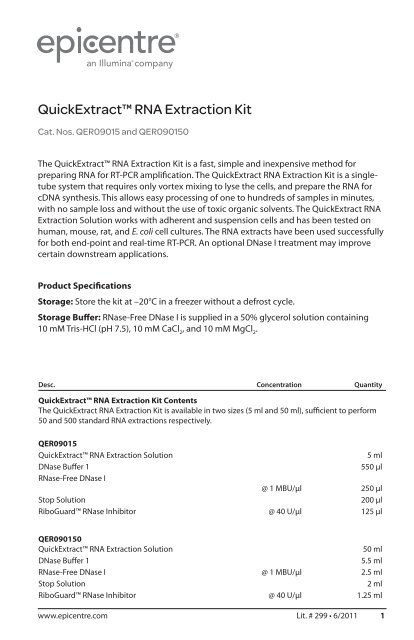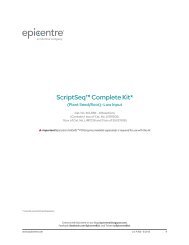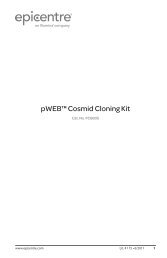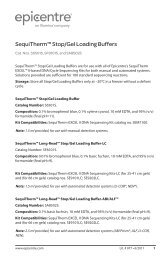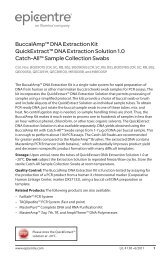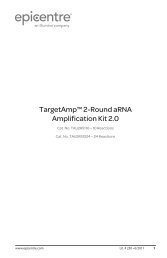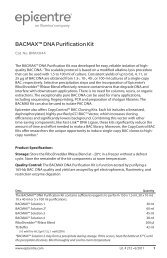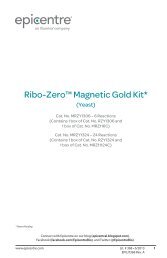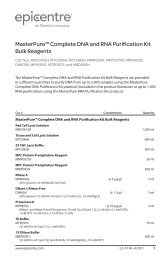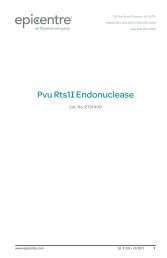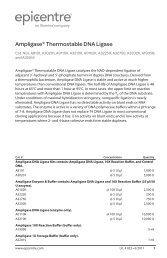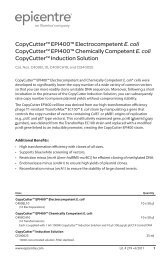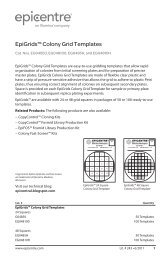Protocol for QuickExtract⢠RNA Extraction Kit
Protocol for QuickExtract⢠RNA Extraction Kit
Protocol for QuickExtract⢠RNA Extraction Kit
You also want an ePaper? Increase the reach of your titles
YUMPU automatically turns print PDFs into web optimized ePapers that Google loves.
QuickExtract <strong>RNA</strong> <strong>Extraction</strong> <strong>Kit</strong>Cat. Nos. QER09015 and QER090150The QuickExtract <strong>RNA</strong> <strong>Extraction</strong> <strong>Kit</strong> is a fast, simple and inexpensive method <strong>for</strong>preparing <strong>RNA</strong> <strong>for</strong> RT-PCR amplification. The QuickExtract <strong>RNA</strong> <strong>Extraction</strong> <strong>Kit</strong> is a singletubesystem that requires only vortex mixing to lyse the cells, and prepare the <strong>RNA</strong> <strong>for</strong>cDNA synthesis. This allows easy processing of one to hundreds of samples in minutes,with no sample loss and without the use of toxic organic solvents. The QuickExtract <strong>RNA</strong><strong>Extraction</strong> Solution works with adherent and suspension cells and has been tested onhuman, mouse, rat, and E. coli cell cultures. The <strong>RNA</strong> extracts have been used successfully<strong>for</strong> both end-point and real-time RT-PCR. An optional DNase I treatment may improvecertain downstream applications.Product SpecificationsStorage: Store the kit at –20°C in a freezer without a defrost cycle.Storage Buffer: RNase-Free DNase I is supplied in a 50% glycerol solution containing10 mM Tris-HCl (pH 7.5), 10 mM CaCl 2, and 10 mM MgCl 2.Desc. Concentration QuantityQuickExtract <strong>RNA</strong> <strong>Extraction</strong> <strong>Kit</strong> ContentsThe QuickExtract <strong>RNA</strong> <strong>Extraction</strong> <strong>Kit</strong> is available in two sizes (5 ml and 50 ml), sufficient to per<strong>for</strong>m50 and 500 standard <strong>RNA</strong> extractions respectively.QER09015QuickExtract <strong>RNA</strong> <strong>Extraction</strong> Solution5 mlDNase Buffer 1550 μlRNase-Free DNase I@ 1 MBU/μl250 μlStop Solution200 μlRiboGuard RNase Inhibitor @ 40 U/μl 125 μlQER090150QuickExtract <strong>RNA</strong> <strong>Extraction</strong> Solution50 mlDNase Buffer 15.5 mlRNase-Free DNase I @ 1 MBU/μl 2.5 mlStop Solution2 mlRiboGuard RNase Inhibitor @ 40 U/μl 1.25 mlwww.epicentre.com Lit. # 299 • 6/2011 1
QuickExtract <strong>RNA</strong> <strong>Extraction</strong> <strong>Kit</strong>Unit Definition: One Molecular Biology Unit (MBU) of RNase-Free DNase I converts 1 μgof pUC19 DNA into oligodeoxynucleotides in 10 minutes at 37°C.Quality Control: The QuickExtract <strong>RNA</strong> <strong>Extraction</strong> <strong>Kit</strong> is function-tested by assaying <strong>for</strong> aPCR product from cDNA produced from <strong>RNA</strong> extracted from HeLa cells.Contaminating Activity Assays: All components of the QuickExtract <strong>RNA</strong> <strong>Extraction</strong> <strong>Kit</strong>are free of detectable RNase activity, and all of the components except DNase I are free ofdetectable exo- and endonuclease activities.Related Products: The following products are also available:– QuickExtract FFPE <strong>RNA</strong> <strong>Extraction</strong> <strong>Kit</strong>– QuickExtract FFPE DNA <strong>Extraction</strong> <strong>Kit</strong>– Catch-All Sample Collection Swabs– MMLV Reverse Transcriptase 1 st -Strand cDNA Synthesis <strong>Kit</strong>– MonsterScript 1 st -Strand cDNA Synthesis <strong>Kit</strong>– MMLV High Per<strong>for</strong>mance Reverse TranscriptaseNotes on Use of the QuickExtract <strong>RNA</strong> <strong>Extraction</strong> <strong>Kit</strong>1. Per<strong>for</strong>m QuickExtract <strong>RNA</strong> extractions in an RNase-free work environment.– Always wear gloves when handling samples containing <strong>RNA</strong> and kit components.– Do not pick up any kit component with an ungloved hand.– Keep all kit components tightly sealed when not in use.– Keep all tubes containing <strong>RNA</strong> tightly sealed during the incubation steps.2. The extraction protocol is scaleable. The reagent volume can be adjusted accordingto the number of cells being lysed.3. Catch-All Sample Collection Buccal Swabs (Epicentre) can be used to collect cells<strong>for</strong> <strong>RNA</strong> extraction. 200 μl of QuickExtract <strong>RNA</strong> <strong>Extraction</strong> Solution is needed tocover most of the Catch-All swab head, there<strong>for</strong>e cells should be collected from bothcheeks to maximize the yield and concentration of <strong>RNA</strong>. Alternatively, cells can beeluted from the swab in 200 μl of PBS, spun down <strong>for</strong> 5 minutes (see Part A, Step 2),and then resuspended in a smaller volume of QuickExtract <strong>RNA</strong> <strong>Extraction</strong> Solution.4. Lysates should be kept on ice when in use and when possible, used directly in cDNAsynthesis reactions. Unused lysates should be stored frozen at –70°C.2 www.epicentre.com
QuickExtract <strong>RNA</strong> <strong>Extraction</strong> <strong>Kit</strong><strong>Protocol</strong>sA. Adherent or Suspension Cultured Cells (10 3 to 10 6 cells)1. Harvest the cells using a method appropriate to the cell type and growth vessel. Iftrypsin is used <strong>for</strong> adherent cells harvest, it should be inactivated.2. Count the cells. Optional: Wash cells with PBS or similar buffer to remove serum andmedia components.3. Pellet the cells by centrifugation at 1,000 x g at 4°C <strong>for</strong> 5 minutes. Aspirate thesupernatant.4. Add 100 μl of ice cold QuickExtract <strong>RNA</strong> <strong>Extraction</strong> Solution to the cells and vortexmix <strong>for</strong> 1 full minute.5. The <strong>RNA</strong> can be used directly in a cDNA synthesis reaction or stored frozen at –70°C.6. The DNA can be removed with an optional DNase I treatment (see Part B).B. Optional DNase I Treatment1. Important! Preheat the lysate at 65°C <strong>for</strong> 2 minutes in a thermal cycler be<strong>for</strong>eproceeding.2. Add 11 μl of DNase Buffer 1, 2.5 μl of RiboGuard RNase Inhibitor, and 5 μl of RNasefreeDNase I to the extracted <strong>RNA</strong>. Mix the sample and incubate the tube at 37°C <strong>for</strong>15 minutes.3. Add 4 μl of Stop Solution to the tube, mix well and incubate at 65°C <strong>for</strong> 10 minutes.4. Store the tubes on ice or frozen until the sample is to be used <strong>for</strong> cDNA synthesis.M 1 2 3 4 5 6 MFigure 1. End-point RT-PCR of different regions of a 14-kb message using HeLa cell extract withthe QuickExtract <strong>RNA</strong> <strong>Extraction</strong> <strong>Kit</strong>. 10 5 HeLa cells were lysed in 100 μl of QuickExtract <strong>RNA</strong><strong>Extraction</strong> Solution by vortex mixing. One microliter of lysate was reverse transcribed with theMMLV Reverse Transcriptase 1 st -Strand cDNA Synthesis <strong>Kit</strong> using standard conditions and randomprimers. 2 μl of cDNA was then amplified with 6 primer sets to p532 using the FailSafe PCR System.Lanes M: 100-bp ladder; Lane 1: 12,984-13,892 Lane 2: 9,406-10,202 Lane 3: 5,194-5,802Lane 4: 4,191-4,690 Lane 5: 2,280-2,676 Lane 6: 1,029-1,329techhelp@epicentre.com • (800) 284-8474 3


